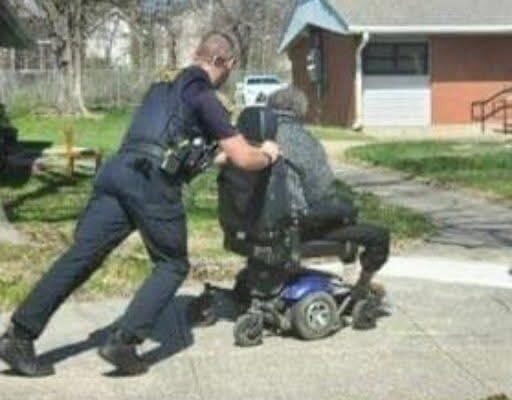It was the kind of scorching afternoon where the air feels thick, the pavement radiates heat, and even standing still makes you break a sweat. The sun was high, unforgiving, and the roads shimmered in waves of heat. In the middle of that relentless summer day, a man in a motorized wheelchair found himself stranded on the side of a busy road. His wheelchair battery had died without warning, and he had no way to move forward—or backward.
He was stuck.
With no shade, no water, and no shelter, he sat motionless, watching as car after car sped past him. Dozens of vehicles flew by—some slowed slightly, some stared, but none stopped. People were on their way to work, to errands, to air-conditioned comfort. The world moved around him, but for him, time stood still.
Minutes passed. Then an hour. The helplessness crept in. The sun bore down harder.
And then, a miracle in uniform.
A patrol car slowed, then pulled over. A police officer stepped out and approached the man, his footsteps steady, his expression calm. The man, weary and overheated, expected the usual—questions, maybe a phone call for help or a tow. Instead, something remarkable happened.
Without a word or hesitation, the officer moved behind the heavy wheelchair, placed his hands on the handles, and began pushing.
He didn’t wait for thanks. He didn’t pause to weigh his options. In full uniform, with sweat already soaking through his shirt, the officer began walking—slowly, steadily, and with determination. He pushed the wheelchair for nearly a mile, navigating sidewalks, avoiding traffic, guiding the man back home through the blistering heat.
No vehicle followed. No backup was called. Just one officer, one act of quiet humanity, and the rhythm of two people making their way down a road where no one else had dared to stop.
A passerby happened to witness the scene and captured it on video. That short clip—one that showed neither fanfare nor speeches, only effort and empathy—quickly went viral. Thousands watched in awe as the footage spread across social media. Comments poured in from around the world, praising the officer’s selflessness, dignity, and the powerful message his actions carried.
But when reporters reached out, the officer dismissed the praise.
“I didn’t do anything special,” he said. “I saw someone in need, and I did what any decent human should do. That’s all.”
And that’s what made it extraordinary.
In a world that sometimes feels cold and disconnected, where headlines often highlight conflict and division, this simple, wordless gesture became a beacon of what service truly means. Not just the badge, the uniform, or the authority—but the choice to act with compassion, even when it’s inconvenient. Especially when it’s inconvenient.
The moment reminded everyone that kindness doesn’t need to be grand or dramatic. It doesn’t always come with cameras or applause. Sometimes it’s just one person showing up for another when no one else will. Sometimes, true service means walking behind someone silently, helping them get to where they need to go, step by difficult step.
And on that sun-scorched road, with no crowd watching and no spotlight shining, one man in a wheelchair and one officer walking behind him created a memory that moved thousands. Not with words, but with action.
Because sometimes, real heroes don’t announce themselves.
They just wear a badge, push forward—and walk beside us when we can’t move on our own.



